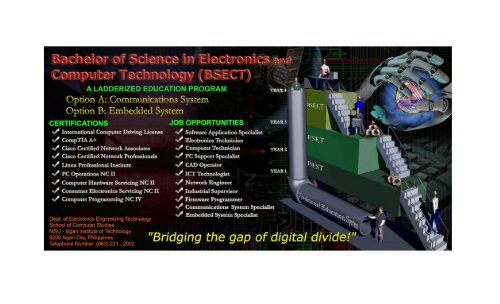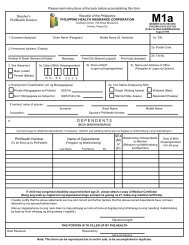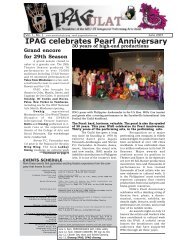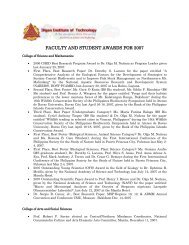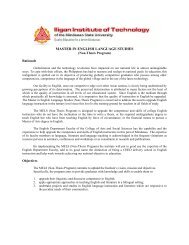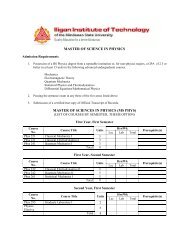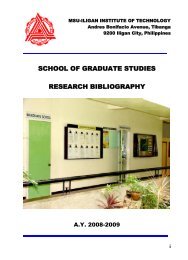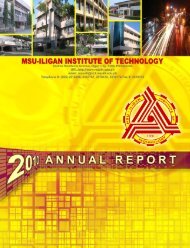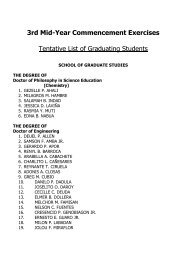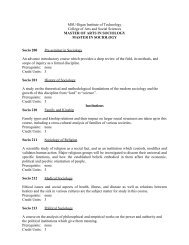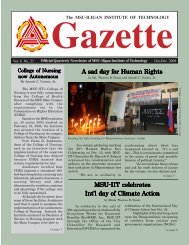Department of Electronics Engineering Technology - Iligan Institute ...
Department of Electronics Engineering Technology - Iligan Institute ...
Department of Electronics Engineering Technology - Iligan Institute ...
Create successful ePaper yourself
Turn your PDF publications into a flip-book with our unique Google optimized e-Paper software.
<strong>Department</strong> <strong>of</strong> <strong>Electronics</strong> <strong>Engineering</strong> <strong>Technology</strong><br />
School <strong>of</strong> Computer Studies<br />
MSU – <strong>Iligan</strong> Insitute <strong>of</strong> <strong>Technology</strong><br />
A. Bonifacio Avenue, Tibanga<br />
9200 <strong>Iligan</strong> City, Philippines<br />
Announces their new Ladderized Education Program:<br />
Features <strong>of</strong> the Proposal:<br />
Bachelor <strong>of</strong> Science in <strong>Electronics</strong> and Computer <strong>Technology</strong> (BSECT)<br />
Option A: Communications System<br />
Option B: Embedded System<br />
1. The Bachelor <strong>of</strong> Science in <strong>Electronics</strong> and Computer <strong>Technology</strong> (BSECT) is a ladderized<br />
curriculum <strong>of</strong> the threeyear Diploma in <strong>Electronics</strong> <strong>Engineering</strong> <strong>Technology</strong> program. One<br />
summer and two semesters are added to the threeyear <strong>Electronics</strong> <strong>Engineering</strong> <strong>Technology</strong><br />
program making it a degree course in higher education as mandated in Executive Order 358.<br />
2. The curriculum fully satisfies the MSU BOR requirements.<br />
3. The curriculum satisfies the CHED requirements (CMO 53, S. 2006) for General Education for<br />
those in the field <strong>of</strong> Information <strong>Technology</strong> Education.<br />
4. The curriculum satisfies the Technical Education and Skills Development Authority (TESDA)<br />
competency standard <strong>of</strong> technical workers on <strong>Electronics</strong> and Computer <strong>Technology</strong> for national<br />
certification level 2, 3 and 4.<br />
Rationale:<br />
The current threeyear <strong>Electronics</strong> <strong>Engineering</strong> <strong>Technology</strong> program aims to prepare the<br />
students to be multiskills technical specialists in the field <strong>of</strong> electronics, computer hardware and<br />
s<strong>of</strong>tware, electrical, and basic industrial controls and instrumentations. In this program students are<br />
taught to become Computer and Electronic technologist. The students in Communication <strong>Electronics</strong><br />
option are capable to repair, calibrate and maintain communication electronics such as AM/FM radio<br />
receivers and transmitter; TV receivers and transmitter; audio equipment; SSB , television equipment<br />
and microwave equipment; computer and network system; consumer electronic appliances, and other<br />
related electronic gadgets. On the other hand, the students in Computer <strong>Electronics</strong> options are capable<br />
to perform computer application in manufacturing and processing; program low level language in<br />
assembly language; install and configure computer and network system, computer diagnostic and<br />
preventive maintenance, and interface using microprocessor, basic <strong>of</strong> computer programming and<br />
firmware programming.<br />
To further strengthen the technical education in this emerging field <strong>of</strong> specialization in the<br />
Philippines, particularly in Mindanao area, the <strong>Department</strong> <strong>of</strong> <strong>Electronics</strong> <strong>Engineering</strong> <strong>Technology</strong> <strong>of</strong><br />
the School <strong>of</strong> Computer Studies <strong>of</strong> MSUIIT proposes to ladder the 3Year course Diploma in<br />
<strong>Electronics</strong> <strong>Engineering</strong> <strong>Technology</strong>, Option A: Communication <strong>Electronics</strong> and Option B: Computer<br />
<strong>Electronics</strong> program, towards Bachelor <strong>of</strong> Science in <strong>Electronics</strong> and Computer <strong>Technology</strong> (BSECT),<br />
with Option A: Communications System and Option B: Embedded System, as stated in Executive<br />
Order 358. This program is designed to meet the needs <strong>of</strong> technicians who wish to enhance or upgrade<br />
their knowledge within the areas <strong>of</strong> their previous training or current pr<strong>of</strong>ession. It provides for<br />
undergraduate program a greater depth <strong>of</strong> understanding in the field <strong>of</strong> specialization beyond the<br />
technician level. It allows more advance coverage in specialized topics, develops more analytical skills,<br />
helps to advance expertise, and prepares graduate to perform more comprehensive and independentbound<br />
work. The curricular program will also incorporate competencybased program on <strong>Electronics</strong><br />
and Computer <strong>Technology</strong> designed by TESDA, courses required in Information <strong>Technology</strong> Education<br />
(ITE) program designed by Commission on Higher Education (CHED) as stated in CMO 53 s. 2006,<br />
and the skills needed by the industries in the field <strong>of</strong> <strong>Electronics</strong> and Computer <strong>Technology</strong>, specifically<br />
in Communications System and embedded system.<br />
The BSECT Option A: Communications System graduates are capable to design and build
structured computer network infrastructure; manage and configure network devices such as switches,<br />
routers, VOIP, etc.; install and configure different network operating system such as UNIX, Solaris,<br />
Novell Netware, Windows Server, Linux, etc; secure and monitor the network system from malicious<br />
attack; familiarize with telecommunication system; implement Voice Over IP (VOIP) communication:<br />
understand the concept <strong>of</strong> network media like fiber optics, unshielded twisted pair cable, coax cable,<br />
etc. Further, the graduates will also adopt the pr<strong>of</strong>essional ethics in Information and Communication<br />
<strong>Technology</strong> fields and apply the acquired skills in Communications System for the benefits <strong>of</strong> the<br />
industries as well as the community and apply the entrepreneurial skills in communications system to<br />
build their own businesses.<br />
The BSECT Option B: Embedded System graduates are capable to simulate digital application<br />
using VHDL, develop realtime systems s<strong>of</strong>tware, write code for Linux device driver, fabricate<br />
interfacing circuit using microcontroller, develop embedded Linux system, design IC circuits, and<br />
design and fabricate embedded system projects. The graduates will also adopt the pr<strong>of</strong>essional ethics in<br />
<strong>Electronics</strong> and Computer <strong>Technology</strong> fields, implement the acquired skills in embedded system for the<br />
benefits <strong>of</strong> the industries as well as the community, apply the acquired skills in communications<br />
system, and apply the entrepreneural skills in embedded system to build their own businesses.<br />
The BSECT curriculum is a ladderized program designed to interface the 3Year Diploma in<br />
<strong>Electronics</strong> <strong>Engineering</strong> <strong>Technology</strong> course to a degree leading to Bachelor <strong>of</strong> Science in <strong>Electronics</strong><br />
and Computer <strong>Technology</strong> as mandated by Executive Order 358 signed by President Gloria M. Arroyo.<br />
It aims to ladderize any vocationaltechnical courses recognized by TESDA to degree courses in higher<br />
education recognized by CHED. The curriculum shall meet the minimum required courses <strong>of</strong><br />
Information <strong>Technology</strong> Education (ITE) as stated in CHED Memorandum Order 53, series <strong>of</strong> 2006. It<br />
also prepares the graduates to meet the required knowledge and skills in electronics and computer<br />
technology for them to pass the National Certification Examinations <strong>of</strong>fered by TESDA (PC Operations<br />
NC II, Consumer <strong>Electronics</strong> Servicing NC II, NC III and NC IV, and Computer Hardware Servicing<br />
NC II) and the industries certifications local or international like International Computer Driving<br />
License (ICDL), IT Technician (CompTia A+), Cisco Certified Network Associates (CCNA), Linux<br />
A+, ICT Pr<strong>of</strong>iciency, etc.<br />
The program has various reference materials such as books, journals, handbooks and other<br />
technical materials and facilities MSUIIT library. The library has in its shelves sufficient volume <strong>of</strong><br />
books and references on the said program. The facilities <strong>of</strong> the <strong>Institute</strong> will also be extensively used to<br />
facilitate learning. It will also make use <strong>of</strong> resource materials and laboratory manuals at the <strong>Department</strong><br />
<strong>of</strong> <strong>Electronics</strong> <strong>Engineering</strong> <strong>Technology</strong>, eBooks and online electronic module by Cisco, etc. The<br />
existing laboratory tools and equipments <strong>of</strong> ESET <strong>Department</strong> will likewise be used by the course.<br />
II. Objectives :<br />
The program will be <strong>of</strong>fered with the objective to develop graduates who will be able to work as<br />
<strong>Electronics</strong> and Computer Technologist, Communications System specialist and Embedded System<br />
specialist.<br />
The following are the competencies to be developed:<br />
Year 1<br />
1) use s<strong>of</strong>tware applications in <strong>of</strong>fice works such as word processing, spreadsheets, multimedia<br />
presentation and basic Internet applications;<br />
2) attain skills in keyboarding using computer s<strong>of</strong>tware;<br />
3) apply occupational health, safety, and 5's practices in the workplaces;<br />
4) solder/desolder electronics circuit board correctly;<br />
5) design, layout and fabricate printed circuit board;<br />
6) analyze and solve DC circuits involving different methods in solving electrical problems;<br />
7) calibrate and repair basic electronic instruments;<br />
8) fabricate unregulated or regulated power supply;<br />
9) identify and use different logic gates as well as implement KMap using them;<br />
10)determine defective electronic components through the use <strong>of</strong> multitester;<br />
11)assemble and disassemble electronic gadgets and computer peripherals;<br />
12)install and configure s<strong>of</strong>tware in computer system;<br />
13)write, compile and execute simple programs <strong>of</strong> different programming languages;
14)make an algorithm for given problems.<br />
Year 2<br />
1. Analyze different diode applications as such series/parallel diode connections, rectifiers,<br />
clippers, clampers and zener diode regulators;<br />
2. analyze and design basic electronic amplifier circuits;<br />
3. design and implement experiments using flipflops, registers, memories and counters;<br />
4. service electrical/electronic systems and components;<br />
5. convert ac small signal equivalent <strong>of</strong> electronic amplifier circuits;<br />
6. implement a microprocessor instruction set in a simulatorbased assembly language solutions;<br />
7. write, compile, debug and execute computer programs using a high level language;<br />
8. acquire the skills in micro and small entrepreneur;<br />
9. install, configure, maintain, diagnose and troubleshoot computer systems and networks;<br />
10.familiarize the construction and properties <strong>of</strong> different integrated circuits;<br />
11.awareness on the existence <strong>of</strong> the various laws and regulations related to constructions and<br />
installations <strong>of</strong> Antennas , radio transmitters, Licensing Procedures prior to operation <strong>of</strong><br />
transceivers and transmitters;<br />
12.assemble, test, and align electronic AM/FM radio receivers;<br />
13.trace schematic diagrams <strong>of</strong> AM/FM circuits;<br />
14.design, layout and assemble regulated high power supply and power on time delay projects;<br />
15.install, configure, diagnose, repair and maintain PC and computer networks;<br />
16.install, configure, diagnose, repair and maintain computer s<strong>of</strong>tware;<br />
17.design and construct advance regulated power supply employing Pulse Width Modulation<br />
(PWM), electronic switching, and power source protection circuit;<br />
18.write, compile, debug and execute compilers to solve problems using objectoriented<br />
programming techniques.<br />
Year 3<br />
1. apply the skills for micro and small entrepreneurship;<br />
2. analyze and design opamps applications, power amplifiers, linear digital ICs and pnpn devices;<br />
3. read/interpret television block and schematic diagrams;<br />
4. operate, diagnose, troubleshoot and align television receivers including PC monitors;<br />
5. analyze and simulate industrial processing problems using PC and PLC s<strong>of</strong>tware and hardware;<br />
6. acquire skills in handling actual operations and interconnecting audio equipments;<br />
7. fabricate tone control and audio power amplifier;<br />
8. service and repair AM/FM radio receiver;<br />
9. design and fabricate VHF antenna;<br />
10.calibrate and align RF tuned and oscillators circuits <strong>of</strong> transmitter;<br />
11.analyze path pr<strong>of</strong>iles for different terrain available for point to point microwave communication<br />
applications;<br />
12.plan and design microwave parabolic reflectors and antennas;<br />
13.design, layout and assemble alarm system and wireless remote control projects;<br />
14.write, assemble, debug, link, execute and run assembler programs;<br />
15.write and configure C language programs for 8051 microcontroller;<br />
16.load binary programs to the 8051 microcontroller chip;<br />
17.design and implement special project in the field <strong>of</strong> Embedded Systems using semiconductors<br />
such as Microcontroller, Programmable Integrated Circuit (PIC), FieldProgrammable Gate<br />
Array (FPGA) and other electronics devices;<br />
18.use C language, Very High Descriptive Language (VHDL), Assembly Language and other<br />
programming languages to implement embedded system project;<br />
19.acquire skills in hardware programming;<br />
20.analyze and differentiate the architecture <strong>of</strong> different operating systems;<br />
21.obtain skills in executing the different commands <strong>of</strong> various operating systems with emphasis<br />
on Linux/Unix;<br />
22.install, configure and debug various s<strong>of</strong>tware applications in Linux Operating System<br />
environment.<br />
Year 4<br />
1. design and implement structured network infrastructure;<br />
2. develop skills on configuring network devices and IOS s<strong>of</strong>tware, configure routing protocols,<br />
and create access lists controlling access to the router;
3. acquire skills in configuring and managing basic switching and intermediate routing protocols;<br />
4. secure a network against known vulnerability attacks;<br />
5. manage, configure, monitor and analyze the network system;<br />
6. understand and appreciate the meaning <strong>of</strong> ethics, values and attitudes in the field <strong>of</strong> IT;<br />
7. apply the skills in communications system through Capstone project that can be use in the<br />
industries;<br />
8. simulate digital application using VHDL;<br />
9. develop realtime systems s<strong>of</strong>tware;<br />
10. write code for Linux device driver;<br />
11. fabricate interfacing circuit using microcontroller;<br />
12. develop embedded Linux system;<br />
13. design IC circuits.<br />
The following are the available job niches for the students:<br />
First year<br />
● Computer Operator<br />
● Data Encoder<br />
● Assistant Electronic and Computer Technician<br />
● PC Assembler<br />
Second year<br />
● Associate <strong>Electronics</strong> Technician<br />
● Associate Computer Technician<br />
● Assistant Network Technician<br />
● Program Coder<br />
● Computer Aided Drafting Operator<br />
● IT Technician<br />
Third year<br />
● Assistant Automation Technician<br />
● <strong>Electronics</strong> Technician<br />
● Computer and Network Technician<br />
● Programming Support Staff<br />
● Firmware Programmer<br />
● <strong>Electronics</strong> and Computer <strong>Technology</strong> Trainer<br />
Fourth Year<br />
● Communications System Technologist<br />
● Network Technologist/Engineer<br />
● PC Support Specialist<br />
● Help Desk Technician<br />
● Industrial Supervisor<br />
● Lead Man<br />
● <strong>Technology</strong> Instructor<br />
● Embedded System Specialist<br />
● Embedded System Programmer<br />
● Technical Consultant<br />
● Hardware Designer<br />
List <strong>of</strong> Courses:<br />
● Basic Drafting<br />
● Fundamentals <strong>of</strong> Keyboarding<br />
● Basic <strong>Electronics</strong> Circuits<br />
● Basic <strong>Electronics</strong> Circuits Lab.<br />
● Digital Techniques Fundamentals<br />
● Digital Techniques Fundamentals Lab<br />
● IT Fundamentals<br />
● Fundamentals <strong>of</strong> Computing<br />
● Small Signal Analysis<br />
● Small Signal Analysis Lab.
●<br />
●<br />
●<br />
●<br />
●<br />
●<br />
●<br />
●<br />
●<br />
●<br />
●<br />
●<br />
●<br />
●<br />
●<br />
●<br />
●<br />
●<br />
●<br />
●<br />
●<br />
●<br />
●<br />
●<br />
●<br />
●<br />
●<br />
●<br />
●<br />
●<br />
●<br />
●<br />
●<br />
●<br />
●<br />
●<br />
●<br />
●<br />
●<br />
●<br />
●<br />
●<br />
●<br />
●<br />
●<br />
●<br />
●<br />
●<br />
●<br />
●<br />
●<br />
●<br />
●<br />
●<br />
●<br />
●<br />
●<br />
●<br />
●<br />
●<br />
●<br />
Advanced Digital Techniques<br />
Advanced Digital Techniques Lab.<br />
Instruments and Measurements<br />
Instruments and Measurements Lab<br />
Computer Programming I<br />
Computer Organization and Architecture<br />
Computer Organization and Architecture Lab.<br />
Computer Networks and Data Communication Fundamentals<br />
Computer Networks and Data Communication Fundamentals Lab.<br />
Computer Repair and Maintenance I<br />
Computer Repair and Maintenance I Lab.<br />
Advanced Computer Networks and Data Communication<br />
Advanced Computer Networks and Data Communication Lab.<br />
LAN Switching and Wireless Communication<br />
LAN Switching and Wireless Communication Lab.<br />
Radio Laws and Regulations<br />
Communications System<br />
Communications System Lab.<br />
Telecommunication Fundamentals<br />
Telecommunication Fundamentals Lab.<br />
Pr<strong>of</strong>essional Ethics<br />
AudioVideo Systems<br />
AudioVideo Systems Lab.<br />
Transmitter System<br />
Transmitter System Lab.<br />
Network Operating System<br />
Network Operating System Lab.<br />
Technopreneurship<br />
Internetworking <strong>Technology</strong><br />
Secure Converged Networks<br />
Multilayer Switched Networks<br />
VOIP and IP Telephony<br />
Network Application S<strong>of</strong>tware<br />
Network Design and Infrastructures<br />
Network Security<br />
Network Management<br />
Wireless Communications<br />
Project Management<br />
Assembler Language and Programming<br />
Assembler Language and Programming Lab.<br />
Programmable Logic Controller Applications<br />
Programmable Logic Controller Applications Lab.<br />
Introduction to Operating Systems<br />
Introduction to Operating Systems Lab.<br />
Microprocessor and System Applications<br />
Microprocessor and System Applications Lab.<br />
Computer Repair and Maintenance II<br />
Computer Repair and Maintenance II Lab.<br />
Discrete Mathematics for ECT<br />
ObjectOriented Programming<br />
ObjectOriented Programming Lab.<br />
Fundamentals <strong>of</strong> Embedded Systems Design and Programming<br />
RealTime and Embedded Operating Systems<br />
Programming Mobile Devices<br />
HDLBased Digital Design<br />
Embedded Linux<br />
Linux Device Drivers<br />
IC Design and Fabrication<br />
Embedded Systems Programming<br />
Digital Signal Processing Systems<br />
Embedded Processors & Peripherals


